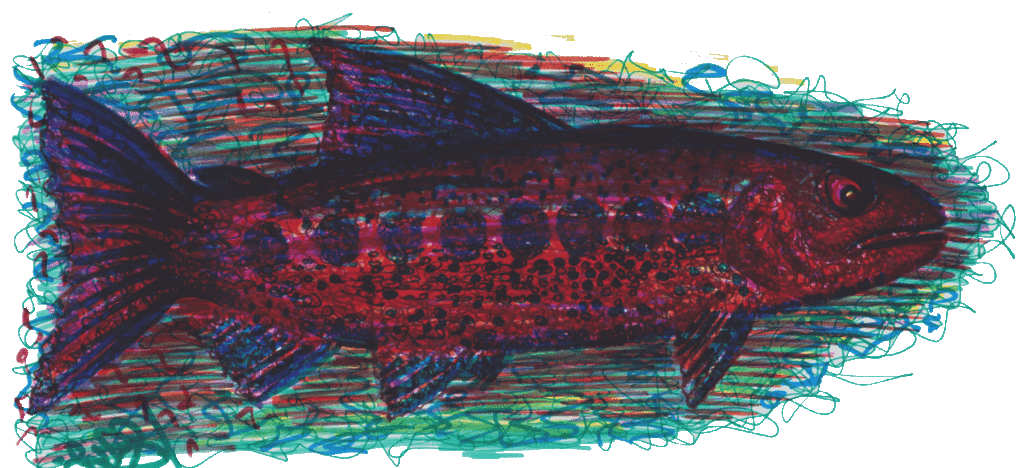
Rainbow trout (Oncorhynchus mykiss), one of the most farmed species mainly in Europe and North America, Chile, Japan, and Australia [9] with a very low welfare potential score, 1 of 10 [10].
(Drawing by Irmy Algader)
Is there animal welfare in aquaculture at all?
We’ve done the job. Science shows quite clearly that there is almost no aquatic animal species that can experience welfare in captivity — not even when a farmer endeavours to provide them with the best possible living conditions.
By Billo Heinzpeter Studer
What we know
In 2013, I launched the FishEthoBase, which is now called fair-fish database [1]. By today it provides the scientific profiles of meanwhile more than 80 species, including some decapod crustaceans and cephalopods. Each profile summarises the studies on the ethology of the species in order to assess its likelihood to experience welfare under standard farming conditions and its welfare potential under improved conditions.
The assessment is based on 10 core criteria. Looking at the scores of welfare potential, only 2 of all species analysed so far exceed a score of 5, i. e. have a high potential of welfare in more than 5 of 10 criteria [2]. Nile tilapia (Oreochromis niloticus [3]) achieves a welfare potential score of 8, the African catfish (Clarias gariepinus [4]) a score of 6. Two other species achieve a score 4, whereas all other species have a very low welfare potential, most of them with scores of 0 or 1.
What conclusions can be drawn from this?
This does not mean that we should now buy only Nile tilapia and African catfish — their welfare is also rather poor if they are farmed under basic conditions. But it does mean that we should focus on these two species in particular when trying to improve the welfare of aquatic animals, because it is very probable that results worthy of the term ‘welfare‘ can be achieved with these two species.
While there may be some probability of welfare improvement also for the two species with a welfare potential score of 4, Common carp (Cyprinus carpio [5]) and — much surprisingly — the fast swimmer Yellowtail amberjack (Seriola lalandi [6]), the possible results of welfare improvements for all other species do not seem really promising. In other words: Why invest time and money in improving the welfare of over 500 farmed aquatic species [7] that show already a very low potential of welfare under improved conditions? In other words: When it comes to fish welfare: what should we aim for? [12]
Furthermore, aquaculture is not the alternative to feed mankind with wild seafood — the praised super-growth of this industry has long since peak already long ago, a recent study revealed. [8].
What we could do
Fish welfare has become a business in which I myself have been involved contre coeur. Let’s face the simple fact that almost all species in aquaculture cannot be offered the living conditions they naturally strive for. Even the most sincere efforts to improve poor welfare cannot make the animals feel good. Animal welfare in aquaculture is so improbable that with almost all species, trying to improve it is more of a waste of time and energy.
Let’s focus on the two species that are most likely to feel at ease in aquaculture and do everything we can for them to make that happen.
Besides animal welfare, there are other good reasons to eat less farmed fish — here’s why [11].
Should we demand wild fish instead? Should we eat fish at all?
This is another question we should think about.
———
References:
[1]| https://fair-fish.net/en/what/fish-welfare/aquaculture/fairfishdatabase/
[2] Fish welfare in aquaculture—Problems and approaches (page 6)
[3] https://fair-fish-database.net/db/31/farm/shortprofile/
[4] https://fair-fish-database.net/db/10/farm/shortprofile/
[5] https://fair-fish-database.net/db/12/farm/shortprofile/
[6] https://fair-fish-database.net/db/46/farm/shortprofile/
[7] Fish welfare in aquaculture (see [2], page 5)
[8] fish-facts 41 (page 10)
[9] FAO Cultured species facts sheet
[10] https://fair-fish-database.net/db/30/farm/shortprofile
[11] ‘Until the end of the world‘, a documentary by Francesco De Augustinis
[12] Fish welfare: what should we aim for?